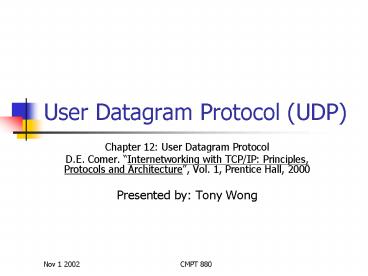User Datagram Protocol UDP PowerPoint PPT Presentation
1 / 21
Title: User Datagram Protocol UDP
1
User Datagram Protocol (UDP)
- Chapter 12 User Datagram Protocol
- D.E. Comer. Internetworking with TCP/IP
Principles, Protocols and Architecture, Vol. 1,
Prentice Hall, 2000 - Presented by Tony Wong
2
Flow of Presentation
- Motivation
- Introduction
- Characteristics of UDP
- UDP Message Format
- UDP Message Delivery
- UDP Port Numbers
- Conclusion
3
Motivation Why?
- IP is used to distinguish different machines on
the internet - But can we distinguish between different
application programs within a machine? - NO!
4
Motivation Why? (cont.)
- Operating Systems nowadays support
Multiprogramming allowing multiple application
programs, or processes, to run simultaneously - A mechanism is necessary to
- 1) distinguish among destination within a given
host - 2) allow processes within a given computer to
send and receive datagram independently
5
Ultimate Destination I
- Where is the ultimate destination for a message?
- the process? (e.g. FTP get operation process
1) - Problems may arise.
6
Ultimate Destination II
- 1) Processes are created and destroyed
dynamically - Hard for the sender to keep track of all these
changes - e.g. System reboot all processes will be
changed
7
Ultimate Destination III
- 2) Sender should not be aware of the
implementation details of applications - Violate the information-hiding principle
- e.g. to ask for a file from a file server
8
Solution I
- Add an additional level of abstraction between
processes and messages - i.e. Port
- Ports are buffered (e.g. arrays of messages)
- Preserve information hiding principle
9
Solution II
- To talk to another port, a send needs to know
both the IP address and the port number at the
destination - Each message must carry destination IP and port
number, as well as its own IP and port number
10
UDP (User Datagram Protocol)
- Appeared first in IETF RFC 768
- a procedure for application programs to send
messages to other programs with a minimum of
protocol mechanism
11
UDP II
- Resides at the same level as TCP
- Connectionless service
- Uses underlying IP to carry messages
- A thin protocol limited functionalities
- NO ACK, NO segmentation, NO sequencing
- Applications NFS, SNMP, DNS
12
UDP Message Format
- Consists of
- 1) UDP header
- 2) UDP data area
13
Data Integrity I
- IP does not compute a checksum on the data
portion of an IP datagram - UDP has to make sure the data portion (IP
address, actual data.) is correct - UDP requests IP information from lower level
14
Data Integrity II
- Pseudo- header is prepended to an UDP datagram
15
Data Integrity III
- 16 bit 1s complement on the entire object
(pseudo-header, header, data) - To ensure data integrity
- Sender-side
- Create pseudo-header, then checksum is performed
- Checksum is saved at the checksum field
- Receiver-side
- Re-create the pseudo-header and re-compute the
checksum
16
UDP Datagram Transmission I
- Multiplexes data from different
applications/processes - UDP datagram is encapsulated with different
headers before actual 0s and 1s physical
transmission
User Data
User Data
UDP header
UDP Datagram
IP header
IP Datagram
Frame header
17
UDP Datagram Transmission II
- When a packet arrives, headers are removed layer
by layer - UDP is responsible for datagram demultiplexing
based on the destination port number
Application 1
Application 2
Port 2
Port 1
UDP
IP Layer
.Previous Layers
18
Port Assignment I
- How do we assign port numbers to different
applications? - Both sender and receiver must agree on port
numbers before they can interoperate
19
Port Assignment II
- Two approaches
- 1) Universal Assignment
- Everyone agrees on some port assignments
- 2) Dynamic Binding
- Port numbers are assigned locally, sender must
ask the receiver for the current port assignments
20
Port Assignment III
- A hybrid approach has been chosen
- Ports 0-1023 are well-known ports
- Rest are dynamic ports
21
Conclusion
- UDP provides an unreliable connectionless
delivery service using IP as the transportation
medium - Provides additional ability to distinguish among
multiple destinations within a given host by
using the concept of Port - A thin protocol with limited functionalities
works well in a local area environment

